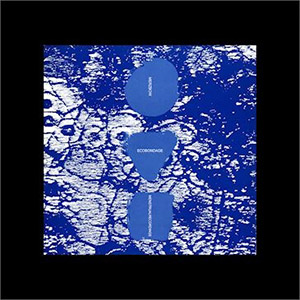 Originally released in 1987 and first reissued in the mid 1990s on CD, Ecobondage is one of Merzbow’s seminal works, and also one of my earliest experiences with his vast discography. Presented as a double LP reissue (with included CD), the album feels like an appropriately deluxe edition that captures a high point of Masami Akita's too often overlooked, but superior junk noise era.
Originally released in 1987 and first reissued in the mid 1990s on CD, Ecobondage is one of Merzbow’s seminal works, and also one of my earliest experiences with his vast discography. Presented as a double LP reissue (with included CD), the album feels like an appropriately deluxe edition that captures a high point of Masami Akita's too often overlooked, but superior junk noise era.
As I have surely mentioned in previous reviews of his albums, my first exposure to Akita's work was Venereology.Like many a suburban teenager, my curiosity was piqued by the claim of it being "the most extreme album you’ll ever own" that Relapse used for marketing purposes.I was underwhelmed once I heard it, however, and while I have developed more of an appreciation for the album now, it still pales compared to others.But not long after that first exposure, I found a copy of Ecobondage on the shelves of a record store and gave Merzbow a second chance.Revisiting the album nearly 20 years after first hearing it (and a more sizable chunk of his catalog), it still makes for a high water mark of his work.
The two 30 minute-plus pieces are split in half for the vinyl portion of the release, and presented as unbroken compositions on the CD.The points in which they are split are rather insignificant, as both parts are dynamic, ever shifting collages.A mix offound sounds, junk rhythms, and tape manipulations jump around rapidly from minute to minute, making any discernible divisions a moot point.Even now, I am not exactly sure where Part 1's "Ecobondage" ends and "Prison of Takaou" begins, nor do I feel that I really need to.
The first part (including "Ecobondage," "Prison of Takaou," and "Blow Up") immediately encapsulates what Masami Akita circa 1987 sounded like.Opening with scraping sheets of metal and rumbling, heavy electronics (possibly the credited contributions of then-frequent collaborator Kiyoshi Mizutani), the mix soon has Akita introducing recordings of dogs barking and clattering, junky tape loops.The piece heavily features lo-fi treated found sounds, taped and manipulated music, and other elements that are even more difficult to pin down.During its duration, it becomes a wall of cavernous metal banging and crunchy undulating patterns, transitioning from chaos to pseudo-rhythmic structures and back again.
The second portion (made up of "Ha Ha Ho Bari (Mari)," "Balloon," "Contraction," and "Ending")follows a similar blueprint:a dizzying array of what seems to be randomness but is anything but.At first it is comparably more abrasive:squeaking, shrill noises, covered in reverb and laser-gun like synthesizer passages.Even with this harshness, the variation and depth of the sounds employed by Akita keep it from becoming too dull or unpleasant.As it continues, undulating heavy bass slips into tumbling metallic chaos, like a rampant bull in a metal factory.The closing moments become more percussive and rhythmic, constructed from what resembles an improvised gamelan and random metal objects.
The presentation of Ecobondage is worth noting, too.While I am not usually one to unnecessarily extol the virtues of analog over digital presentations, the sound benefits from the vinyl presentation, which captures the warmth of the original analog source material better than the CD, which sometimes becomes a bit too sharp and harsh.Similarly, the record's visual presentation is strong as well:not only does it revert back to the original LP artwork (which was not included on the original CD reissue), the sleeve is stuffed with inserts (some reproduced from the first version of the record) and flyers that hearken back to those early noise releases that I am rather fond of.But no matter how it looks, the familiar yet unrecognizable noises captivate in their complexity and variation, culminating in a record that has an undeniable depth and breadth, and is just as great as I remember it from 20 years ago.
samples:
 
Read More

